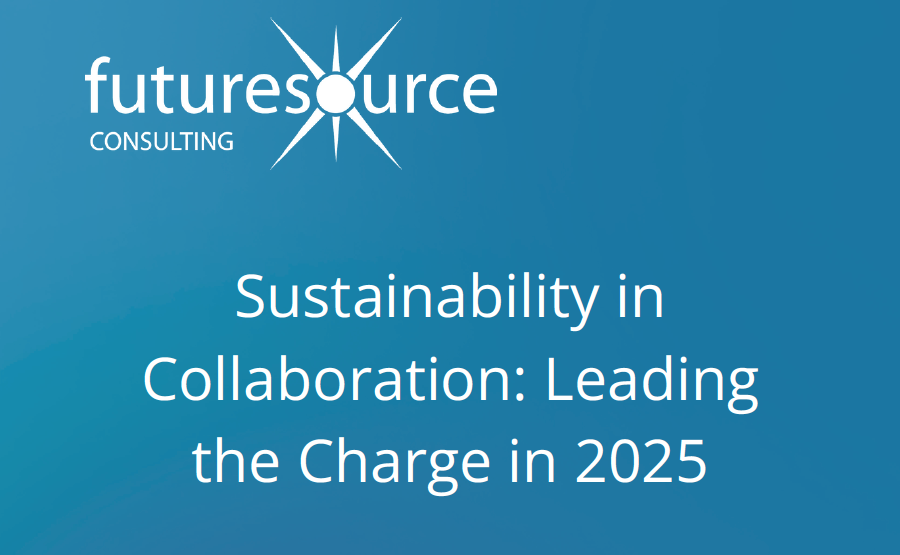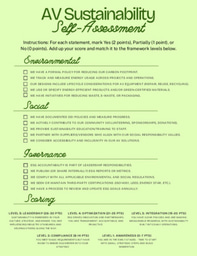Sustainability in Collaboration: Leading the Charge in 2025

Related Content

 Futuresource
Futuresource
Sustainability in Collaboration: Leading the Charge in 2025 Whitepaper | Futuresource
Futuresource Consulting LTD
The professional AV industry is at a pivotal moment. Sustainability is no longer just a buzzword — it’s a defining factor for business, brand trust, and long-term relevance. As collaboration technologies grow more central to enterprise operations, the environmental impact of devices, packaging, and lifecycles has come under sharper focus.
In fact, sustainability is now shaping decision-making across the entire AV ecosystem — from vendors and channel partners to IT buyers and enterprise end-users. This shift is reflected in a recent perspectives piece from SAVe: Sustainability in AV, Sustainability in Collaboration: Leading the Charge in 2025 (read the full article here).
Why It Matters Now
Sustainability has moved from “nice-to-have” to must-have for three critical reasons:
-
Corporate ESG Goals: Many organizations are aligning procurement with environmental, social, and governance benchmarks.
-
Investor Scrutiny: ESG scores now impact valuations, capital access, and long-term growth.
-
Channel Influence: Integrators and resellers are increasingly promoting eco-conscious brands to meet client demand.
This creates a powerful alignment: vendors that demonstrate sustainable practices aren’t just protecting the planet — they’re building market share.
Industry Leaders Setting the Pace
Collaboration vendors have made bold moves that highlight this industry-wide shift:
-
Logitech introduced energy-efficient technologies like low-power standby in products such as the Logitech Sight, reinforcing its position as a global market leader.
-
HP Poly’s latest video bars integrate up to 65% recycled plastics, setting a new bar for eco-friendly design.
-
Jabra reengineered its packaging to be 100% recyclable and cut plastic usage by 85%.
-
Yealink emphasized energy-efficient conference phones with rechargeable batteries and PoE functionality.
-
Neat focused on modularity, enabling upgrades without replacing entire systems and using recycled materials in its Neat Board 50.
-
Cisco designed its Desk Phone 9800 Series with 74% post-consumer recycled plastics, all Energy Star certified.
The common thread? Sustainability is becoming a design principle, not an afterthought.
Building Mindshare Through Sustainability
Leading vendors aren’t just retooling their products — they’re reshaping the narrative:
-
Energy Efficiency: Low-power modes, intelligent energy management, and LED transitions are reducing operational costs while shrinking carbon footprints.
-
Transparency & Accountability: From Logitech’s Impact Report to Neat’s Responsible Journey eBook, vendors are openly sharing progress and targets.
-
Collaboration: Industry partnerships — like those fostered by SAVe — unite manufacturers, integrators, and associations to accelerate impact.
For buyers and channel partners, this translates into measurable confidence that AV can align with broader corporate sustainability strategies.
Lessons from IT
The IT sector has long set benchmarks with Energy Star and EPEAT certifications, along with robust take-back and refurbishment programs. As AV and IT continue to converge, CIOs and CTOs — who increasingly control AV budgets — expect the same level of responsibility from AV vendors.
In other words: what’s been “best practice” in IT is fast becoming a baseline requirement in AV.
The Global Regulatory Lens
Country-specific policies are also raising the bar:
-
United States: EPA energy efficiency standards.
-
China: Extended Producer Responsibility laws.
-
Germany: Incentives for renewable energy and strict e-waste policies.
-
France: Repairability scores and anti-waste laws.
-
UK & EU: Eco-design and lifecycle accountability directives.
-
Canada & Brazil: New disclosure and emissions trading systems.
Global AV players must adapt to diverse, often stringent requirements while competing for growth in these top economies.
Where We Go From Here
For AV, the path forward is clear: sustainability isn’t a compliance exercise — it’s a strategic differentiator. Vendors who embed eco-friendly practices into their operations will not only meet regulatory standards but also:
-
Build trust with partners and customers.
-
Lower costs through energy-efficient innovation.
-
Gain competitive edge in a fast-evolving market.
As SAVe reminds us in their full piece, success will come to those who view sustainability as a business opportunity — not a burden.
👉 Read the full article: Sustainability in Collaboration: Leading the Charge in 2025






Please sign in or register for FREE
If you are a registered user on AVIXA Xchange, please sign in